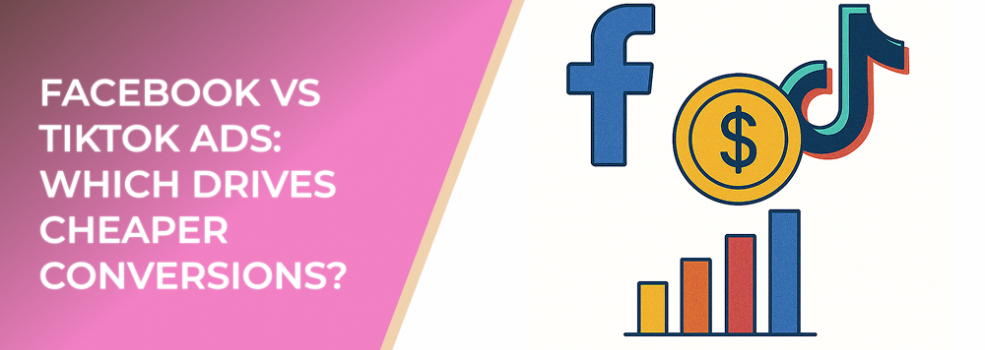The competition between Facebook and TikTok has reshaped online advertising. While Facebook remains the go-to platform for targeting precision and scale, TikTok’s creative-first approach has proven incredibly cost-effective for certain industries. So, which one delivers cheaper conversions? Let’s compare them head-to-head.
1. Audience and User Intent
Facebook’s audience is mature and highly segmented. Its ad algorithm is fine-tuned to optimize for conversions, thanks to years of data refinement. TikTok, meanwhile, captures younger, entertainment-driven users who engage differently.
-
Facebook’s audience: 2.9 billion monthly active users, primarily aged 25–54.
-
TikTok’s audience: 1.7 billion monthly active users, primarily aged 16–34.
TikTok users are more impulsive and discovery-driven, while Facebook users often convert after multiple ad touches. This distinction affects conversion costs: TikTok may drive cheaper top-funnel engagement, while Facebook delivers higher downstream conversion quality.
2. Average Cost Per Click (CPC) and CPM
Advertising costs vary by region and industry, but across most campaigns, Facebook still commands higher prices:
-
Average CPC on Facebook (2024): $1.10–$1.35
-
Average CPC on TikTok (2024): $0.60–$0.90
-
Average CPM on Facebook: $12–$15
-
Average CPM on TikTok: $6–$8
TikTok’s lower costs make it appealing for advertisers seeking wide reach. However, those savings don’t always translate to cheaper conversions—especially when audience intent is weaker.
3. Conversion Rates: Quality Over Quantity
According to Wordstream and independent Meta data, Facebook’s conversion rate for e-commerce and lead gen ads typically ranges from 8% to 14%, depending on the vertical. TikTok’s conversion rate, on the other hand, averages 3% to 6%, largely due to its entertainment-first user base.
In practical terms: you might pay less per click on TikTok, but you’ll often need more clicks to generate a sale or lead.
Example:
If you’re paying $0.70 CPC on TikTok and $1.20 on Facebook, but Facebook converts 3x better, your Facebook conversions may actually be cheaper overall.
4. Creative Performance and Ad Fatigue
TikTok’s algorithm favors fresh, authentic video content that blends in with user-generated posts. Facebook relies more on ad consistency and remarketing strength.
TikTok ads require faster creative rotation—most videos fatigue after 7–10 days. Facebook creatives, in contrast, can perform well for weeks or even months with proper optimization.
That makes TikTok more demanding in terms of content production but also offers advertisers a testing advantage. Constant iteration can lower costs if you identify a viral format early.
5. Targeting Capabilities
Facebook remains unmatched in targeting sophistication. Meta’s detailed behavioral, demographic, and interest-based tools allow advertisers to segment users with precision. TikTok’s targeting has improved, but it still relies heavily on machine learning and broader signals.
If your campaign depends on exact audience definitions—like remarketing, custom audiences, or lookalikes—Facebook delivers higher efficiency per dollar. You can refine targeting further using the tips from Facebook Ad Targeting 101: How to Reach the Right Audience.
6. Industry-Specific Cost Comparison
Here’s a quick breakdown of how each platform performs in major advertising verticals:
| Industry | Avg. Facebook CPA | Avg. TikTok CPA | Notes |
|---|---|---|---|
| E-commerce | $22–$28 | $17–$23 | TikTok wins for impulse-driven, visual products |
| Lead generation | $35–$50 | $40–$55 | Facebook leads due to stronger data feedback |
| App installs | $2–$3 | $1.50–$2.50 | TikTok performs well with gamified content |
| Local businesses | $18–$25 | $20–$30 | Facebook’s targeting gives it the edge |
The difference often depends on your creative and funnel setup. TikTok wins at awareness, Facebook dominates at conversion depth.
7. Scaling and Retargeting Efficiency
Facebook’s biggest advantage lies in scaling. Its machine learning optimizes performance across vast datasets, and its retargeting efficiency can increase ROAS by 40% or more. TikTok’s retargeting capabilities, while improving, still lag behind.
That’s why many successful advertisers use TikTok for top-funnel engagement and Facebook for conversion nurturing. The combination often delivers the best cost-per-result across the funnel.
Final Verdict
If you’re chasing cheaper clicks and mass exposure, TikTok wins. If your goal is sustained conversions and reliable ROAS, Facebook remains the better long-term investment.
In 2025, the most efficient advertisers aren’t choosing one—they’re integrating both. TikTok drives discovery and engagement, while Facebook turns that attention into measurable sales.
Suggested reading:

